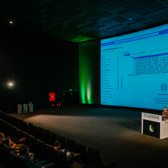Power Apps and Power Automate: Advanced Patterns
UPPA
3 days
Interested in a private company training? Request it here.
Not ready to book yet? Request an offer here.
Creating Responsive Canvas Apps
When you create Canvas Apps, they are not responsive by default. They either have a Phone or Tablet layout. You can tweak some app settings and work with formulas to make them responsive. However, to create truly responsive Canvas Apps, you will need to work with layout containers. In this chapter you will learn all about the available layout containers and how they can be used to easily create responsive Canvas Apps.
- What is a Responsive App?
- Working with Responsive Layout Containers
- Configuring Auto Layout Containers
- Working with Screen Sizes and Breakpoints
- LAB: Redesign a Budget Tracker Canvas App so it becomes responsive
Working with Components in Canvas Apps
Components are reusable building blocks for Canvas Apps so that app makers can create custom controls to use inside an app, or across apps using a component library.
- Creating Components and Component Libraries
- Defining Inputs and Outputs
- Using Components
- Canvas Component Properties
- Component Library ALM
- Behavior Formulas for Components
- LAB: Create and Use a Hamburger Menu Component
Creating Custom Connectors for the Power Platform
The Power Platform ships with 1300+ built-in connectors, but what if you need to connect to a custom data source? In that case, you can write your own custom connectors and use them in Power Automate and Canvas Apps.
- Creating Custom Connectors
- Using Custom Connectors
- Creating Custom Connectors in Solutions
- Using Environment Variables in Custom Connectors
- LAB: Connect to the OMDb API to get movie info in a Canvas App and Flow
Storing Data using Microsoft Dataverse
Almost every Canvas App and Power Automate Flow will have to deal with data somehow. This chapter introduces Microsoft Dataverse as an easy-to-use and scalable data source compared to storing data in Excel files or SharePoint lists.
- Using Microsoft Dataverse as a Data Source
- Creating Tables in Microsoft Dataverse
- Creating Columns, Relationships and Views in a Table
- LAB: Create a Dataverse Data Model to Store Car Data
Using Microsoft Dataverse in Canvas Apps and Power Automate
In this chapter you will see how you can build a Canvas App on top of tables in Microsoft Dataverse. See how to work with Lookup, Choice, Image... columns in your Canvas app. Learn about the Power Automate triggers and actions that are specific to Microsoft Dataverse.
- Using Microsoft Dataverse in a Canvas App
- Simplify Power Fx Code with Dataverse
- Using Microsoft Dataverse in Power Automate
- LAB: Build a Car Management Solution on top of your Dataverse Data
Using Functions in Dataverse
Functions in Dataverse allow developers to encapsulate logic that can be reused across apps and flows. This chapter teaches students how to define and use custom functions in Dataverse to enhance data manipulation and business processes.
- What are Functions
- Configuring Functions using Power Fx
- Error Handling in Functions
- Using Functions in Canvas Apps
- Power Automate Integrations
- Functions vs Other Automations
- Limitations
- LAB: Configure Functions for the Car App
Monitoring and Troubleshooting Power Platform Solutions
Learn how to add error handling and notifications in Canvas Apps and Power Automate, integrate telemetry with Azure Application Insights, and debug using the built-in Monitor. You’ll also explore performance tuning techniques and Power CAT tools to analyze and optimize your solutions.
- Error Handling and Notifications in Canvas Apps
- Integration with Azure Application Insights
- Debugging Canvas Apps with the Built-In Monitor
- Canvas App Performance Tuning
- Error Handling and Logging in Power Automate
- Using Power CAT Tools
Testing Power Apps
Testing is an important part of the software development lifecycle. Testing can help ensure the quality of the app delivered to customers because it can identify issues or defects early in the release process.
- Canvas App Test Studio Overview
- Creating and Running Test Cases
- Working with Test Suites
- Processing Test Results
- Best Practices and Limitations
- LAB: Build Test Cases and Log Test Results
So, you dipped your toes into the waters of Power Apps and Power Automate? Time to dive deeper! This training will take you from being an average maker to a great one. You’ll explore more advanced techniques like Responsive Apps, Components, Custom Connectors, and advanced Flows. You will also get acquainted with Functions and the integration options with Microsoft Dataverse.
This course is targeted at Power Platform makers who already have a solid understanding of creating Canvas Apps and Power Automate Flows. If you have no or limited experience with Power Apps and Power Automate, U2U recommends following the 4-day training Microsoft Power Apps and Power Automate prior to this course.








